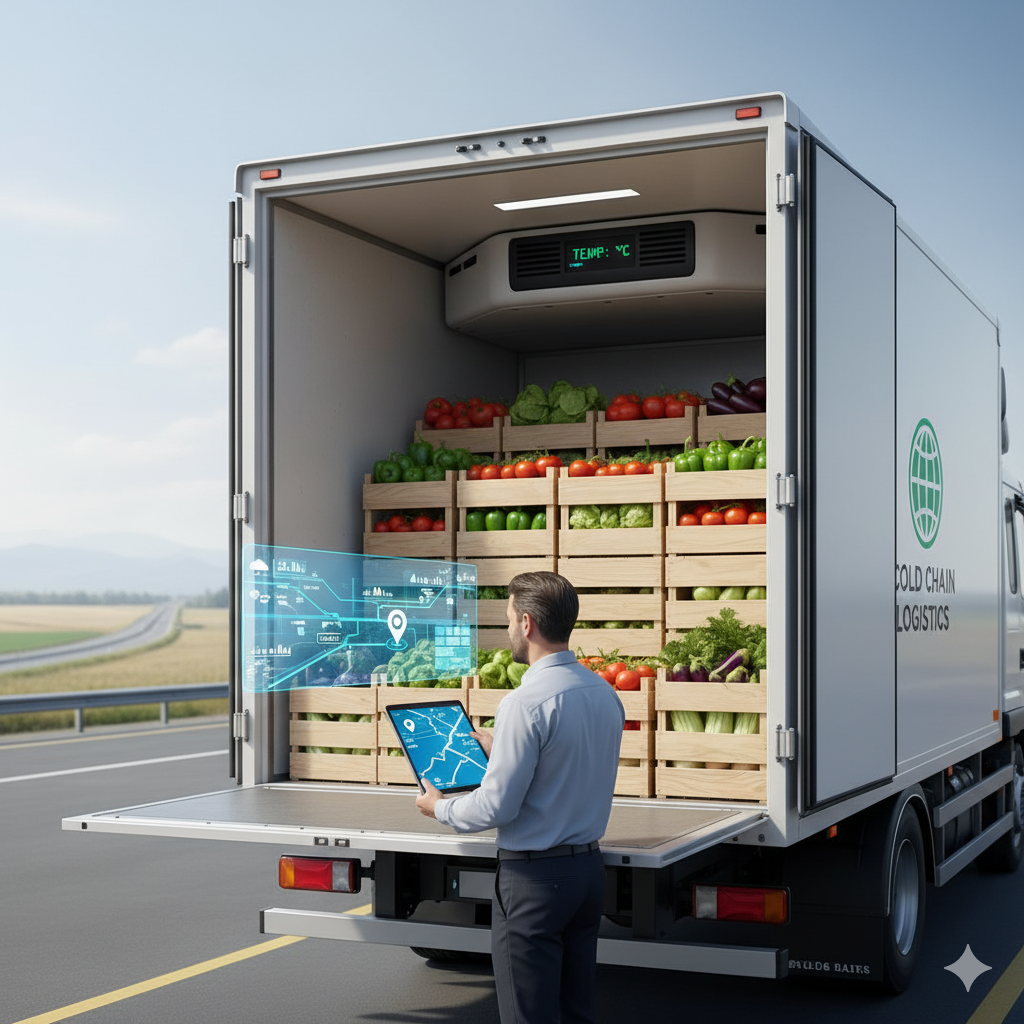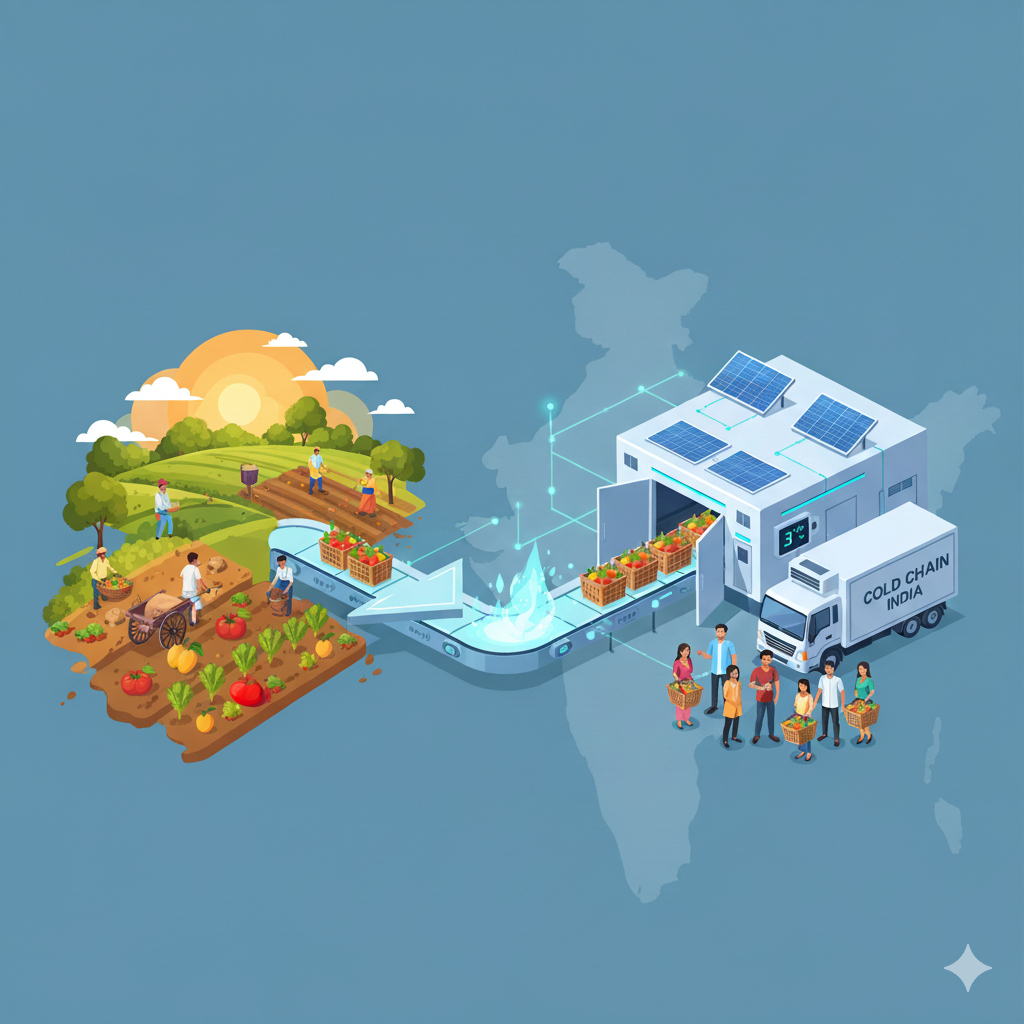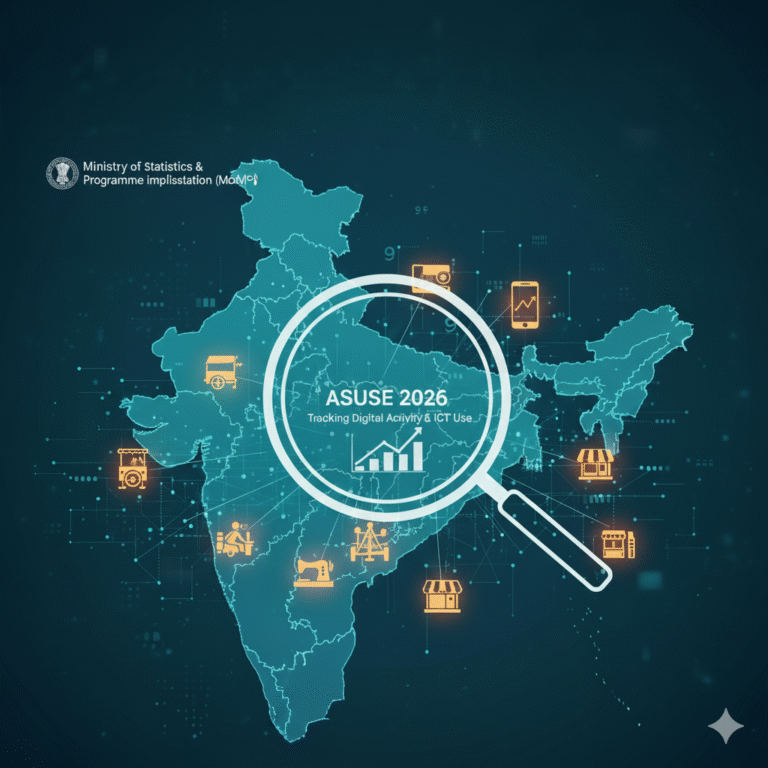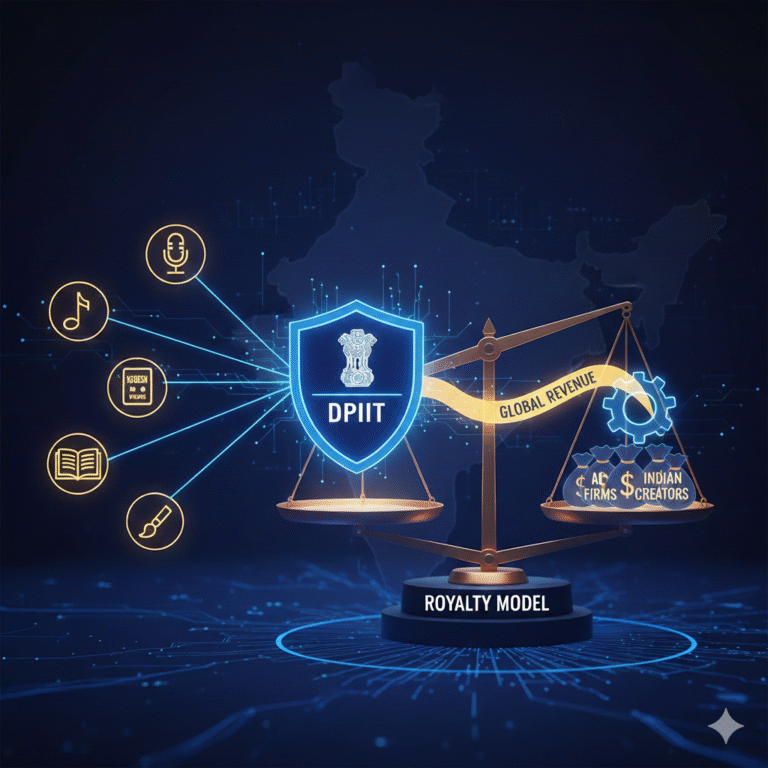Key Highlights:
- India operates 8,689 cold storage facilities with 39.6 million MT capacity as of August 2024, dominated by Uttar Pradesh (38%), West Bengal (15%), and Gujarat (10%), yet still faces annual post-harvest losses of Rs 92,651 crore ($10.78 billion) due to infrastructure gaps.
- Cold chain access increases farmer income by 15-20% by extending market reach, reducing waste, enabling high-value crop diversification, and preventing distress selling—with documented cases showing 30% loss reduction and doubled profits through farm-level cold rooms.
- The cold chain market grew from Rs 2,28,700 crore (US$ 26.60 billion) in 2024 to projected Rs 6,06,100 crore (US$ 70.50 billion) by 2033 at 10.86% CAGR, anchored by government schemes deploying ₹1 lakh crore NAIF financing and ₹2,513.27 crore PMKSY assistance.
- IoT and AI technologies enable real-time temperature monitoring, predictive maintenance, automated cold chain alerts, and route optimization reducing operational costs and spoilage—with IoT cold chain monitoring market growing 12.9% annually through 2030.
- Cold chain infrastructure creates documented 1,74,600 jobs nationwide while addressing twin crises: feeding India’s 190 million malnourished population and protecting farmer incomes from climate variability, representing critical dimensions of agricultural policy, food security, and inclusive growth.
India produces enough food to feed its 1.4 billion people and export surpluses globally. Yet 190 million Indians remain malnourished, and farmers lose Rs 92,651 crore annually to preventable post-harvest decay. This paradox—abundance coexisting with scarcity—reveals a critical infrastructure failure: the cold chain. pib.gov
Cold chain infrastructure represents perhaps the most transformative yet underappreciated technology in Indian agriculture. Unlike glamorous automation or precision farming receiving startup buzz, cold chains deliver unglamorous but profound impact: tomatoes reaching markets fresh rather than rotting in fields, strawberries reaching urban consumers while generating farmer wealth, vaccines reaching remote villages at full potency, and medicines preserving efficacy despite tropical heat.
Understanding India’s cold chain revolution—its current state, government initiatives, technological innovations, and transformative potential—spanning agriculture policy, food security, rural development, and strategic infrastructure.
What Is Cold Chain Infrastructure and Why It Matters Urgently
Definition and Components
Cold chain infrastructure maintains temperature-controlled environments throughout the agricultural supply chain: from harvest to storage to transportation to retail to consumption.
Key components include:
- Cold Storage Facilities: Insulated warehouses maintaining specific temperatures (0-4°C for fresh produce, -18°C for frozen foods) extending shelf life from days to weeks or months.
- Reefer Vehicles: Refrigerated trucks and vans maintaining temperature during transit, preventing quality degradation during long-distance movement.
- Ripening Chambers: Temperature and humidity-controlled facilities enabling artificial ripening of fruits like bananas, mangoes according to market demand rather than natural seasonal cycles.
- Immediate Quick Freezing (IQF) Units: Rapid freezing facilities processing fresh produce into frozen products extending shelf life and enabling year-round availability.
- Cold Processing Centers: Facilities combining washing, grading, packaging with refrigeration—adding value while preventing spoilage.
- Monitoring and Tracking Infrastructure: IoT sensors, GPS systems, and cloud-based platforms enabling real-time temperature monitoring and supply chain transparency.
Sectors and Applications Beyond Agriculture
While agriculture represents primary beneficiary, cold chains serve critical sectors:
- Pharmaceuticals: Maintaining vaccine potency, medicine stability, and biological product integrity—especially critical post-COVID when vaccine distribution became national priority.
- Floriculture: Preserving fresh flower quality for export markets, particularly crucial for India’s growing horticulture exports.
- Fisheries: Maintaining fish freshness and quality during transport from coastal regions to inland markets.
- Dairy and Meat: Preserving milk, yogurt, cheese, and meat products—essential for India’s growing animal agriculture sector.
The Economic Crisis: Understanding India’s Post-Harvest Losses
Scale of the Catastrophe
India faces annual post-harvest losses of Rs 92,651 crore ($10.78 billion)—a figure almost three times the entire agriculture budget, almost double the defense budget. scroll.in
These aren’t abstract numbers. Every rupee represents:
- Farmer income destroyed: Produce lost means farmer labor, inputs, and time generating zero returns.
- Consumer prices inflated: Reduced supply from losses increases scarcity, driving prices upward and restricting access for lower-income consumers.
- National resources wasted: Environmental resources (water, fertilizer, pesticides, land) deployed producing food that never feeds anyone.
- Export competitiveness damaged: Global agricultural trade increasingly demands traceability, consistency, and quality—losses undermine India’s competitive positioning.
Commodity-Specific Losses:
According to Ministry of Food Processing analysis (2015 study by Central Institute of Post-Harvest Engineering & Technology): pib.gov.in
- Fruits and Vegetables: 16% loss (Rs 40,811 crore) due to inadequate cold storage, transportation, and post-harvest handling.
- Cereals, Pulses, Oilseeds: Rs 32,853 crore loss predominantly through inadequate grain storage infrastructure.
- Meat Products: 7% loss (Rs 3,942 crore), with approximately 60% occurring during storage—directly addressable through cold chain infrastructure.
- Plantation Crops, Spices: Combined losses represent significant value destruction in specialty agriculture.
Structural Drivers of Post-Harvest Losses:
Cold chain gaps create sequential failure points:
- First-mile collection: Inadequate farm-level cooling allows field heat acceleration and microbial growth immediately after harvest.
- Transportation: Non-refrigerated transport vehicles expose produce to ambient temperatures during transit, causing quality degradation.
- Aggregation points: Intermediary markets lack cold storage, forcing immediate sales at distress prices or product spoilage.
- Wholesale markets: Inadequate cold storage at mandis (wholesale markets) forces rushed selling, preventing price negotiation advantage.
- Retail distribution: Lack of cold chain connectivity to retail prevents effective market reach beyond immediate geographic areas.
Current State of Cold Chain Infrastructure: Regional Disparities and Capacity Analysis
Aggregate Infrastructure
As of August 2024, India operates 8,689 cold storage facilities aggregating 39.6 million metric tonnes (MMT) capacity. This represents substantial infrastructure but remains insufficient for India’s agricultural production and storage requirements. indianinfrastructure
Projected Capacity Requirement: NABARD estimates India requires 45 MMT capacity by 2029 to adequately serve agricultural and food preservation needs. Current infrastructure operates at approximately 88% of adequate capacity, indicating significant remaining gap.
Regional Concentration and Disparities:
India’s cold chain infrastructure exhibits severe geographic concentration:
| State | Cold Storage Capacity Share | Implications |
|---|---|---|
| Uttar Pradesh | 38% (15.05 MMT) | Dominance reflects potato production concentration; potato storage represents single largest cold storage use category |
| West Bengal | 15% (5.94 MMT) | Regional fruit/vegetable production hub; supports perishable produce preservation |
| Gujarat | 10% (3.96 MMT) | Growing agricultural diversification and dairy processing concentration |
| Punjab | 7% | Grain storage focus, dairy sector growth |
| Madhya Pradesh | 6% | Emerging agricultural hub with expanding cold storage |
| Remaining 24 states | 24% | Severe underinvestment creating accessibility barriers for farmers outside major production zones |
This concentration creates profound inequity: Farmers in states with limited cold chain access face distress selling, remain price-takers in markets dominated by better-positioned competitors, and cannot access high-value crop opportunities requiring cold preservation capability.
Sector-Specific Capacity (as of FY24):
| Sector | Current Capacity | Growth Trajectory |
|---|---|---|
| Reefer Vehicles | 1,482 completed projects | Expanding to 1,860 total capacity |
| IQF (Individual Quick Freezing) | 274.25 MT/hour | Increasing to 335 MT/hour |
| Milk Processing/Storage | 137.53 lakh liters/day | Rising to 175 lakh liters/day |
| Cold Storage (Approved projects) | 8.59 lakh MT (completed) | Expected 10.28 lakh MT (all approved projects operationalized) |
Market Growth Projections:
India’s cold chain market demonstrated explosive growth trajectory: ibef
- 2024 Market Size: Rs 2,28,700 crore (US$ 26.60 billion).
- Projected 2033 Size: Rs 6,06,100 crore (US$ 70.50 billion).
- CAGR (2025-2033): 10.86%—indicating accelerating adoption and expansion.
This growth reflects government policy push, private sector investment increase, and rising demand from urbanization, dietary diversification, and agricultural modernization.
Government Initiatives: From Policy to Ground-Level Implementation

Pradhan Mantri Kisan Sampada Yojana (PMKSY): The Comprehensive Scheme
- Launched in 2017-18, PMKSY represents the government’s flagship food processing and preservation infrastructure program.
- PMKSY operates through multiple integrated component schemes addressing different supply chain segments:
- Integrated Cold Chain and Value Addition Infrastructure: Provides grants-in-aid and concessional financing for cold storage, ripening chambers, reefer vehicles, and processing infrastructure.
- Creation of Infrastructure for Agro-Processing Clusters: Develops cluster-based infrastructure enabling economies of scale and backward-forward linkages between farmers and processors.
- Operation Greens: Supports tomato, onion, and potato (TOP) supply chains through storage facilities and market stabilization measures.
- Creation/Expansion of Food Processing Capacities: Finances processing unit establishment, modernization, and capacity enhancement.
- Food Safety and Quality Assurance: Supports infrastructure for food safety testing and quality certification.
Achievements and Financial Commitment:
During 2018-19 to 2023-24, PMKSY distributed financial assistance of ₹2,513.27 crore to 553 food processing projects. This represents sustained commitment translating policy into infrastructure deployment.
As of June 2025, under the Integrated Cold Chain component specifically:
- 395 integrated cold chain projects approved since 2008.
- 291 projects completed and operational.
- Preservation capacity created: 25.52 lakh MT annually.
- Processing capacity created: 114.66 lakh MT annually.
- Employment generated: 1,74,600 jobs across sectors.
- Budget allocation increased to ₹6,520 crore in 2025 reflecting accelerated implementation.
National Agriculture Infrastructure Financing Facility (NAIFF): The ₹1 Lakh Crore Game-Changer
Announced as game-changing initiative, NAIFF provides concessional financing for agricultural infrastructure including cold chains:
- Total Fund: ₹1 lakh crore (approximately $13 billion USD) for medium to long-term financing.
- Interest Subvention: 3% annual interest subvention on loans up to ₹2 crore, dramatically reducing financing costs for farmers and agri-entrepreneurs.
- Credit Guarantee: Loans up to ₹2 crore covered under credit guarantee mechanisms, reducing lending risk and encouraging bank participation.
- Eligible Beneficiaries: Farmers, Farmer Producer Organizations (FPOs), agri-entrepreneurs, startups, state agencies, and public-private partnerships.
Impact and Reach:
NAIFF finances diverse infrastructure projects:
- Cold storage hubs enabling community access rather than individual farmer ownership.
- Precision farming infrastructure reducing input waste and optimizing resource utilization.
- Digital market platforms enabling direct farmer-consumer connections.
NAIFF’s particular significance lies in enabling decentralized cold chain models accessible to smallholder farmers previously excluded due to capital requirements.
Technology and Innovation: The AI-IoT Revolution in Cold Chains

IoT-Based Real-Time Monitoring and Predictive Analytics
Internet of Things technology transforms cold chain management from reactive (responding to spoilage) to proactive (preventing spoilage before occurrence):
IoT Sensor Capabilities:
- Temperature and Humidity Monitoring: Continuous sensors throughout cold chain track environmental conditions, immediately detecting deviations indicating equipment malfunction or temperature excursions.
- Location Tracking: GPS integration enables real-time shipment location visibility preventing theft, unauthorized stops, or route deviations compromising temperature maintenance.
- Automated Alerts: When temperatures exceed tolerance thresholds, IoT systems trigger automatic notifications to operators enabling immediate corrective action—adjusting refrigeration, rerouting shipments, or authorizing disposal before total spoilage.
IoT Benefits for Cold Chain Economics:
- Reduced Spoilage: Real-time monitoring enables intervention before product loss becomes catastrophic, minimizing financial impact.
- Operational Cost Reduction: Predictive maintenance capabilities identify equipment failures before occurrence, preventing expensive emergency repairs and extended downtime.
- Route Optimization: Data analytics optimize transportation routes reducing fuel consumption, transit time, and refrigeration load.
- Compliance Documentation: Automated data generation simplifies regulatory compliance reporting required by pharmaceutical and food safety regulations.
- Asset Utilization Optimization: Data visibility identifies underutilized cold chain assets enabling reallocation to higher-value applications.
AI and Machine Learning Applications
Beyond IoT’s real-time monitoring, artificial intelligence enables sophisticated predictive analytics:
- Demand Forecasting: ML models analyze historical sales data, seasonal patterns, weather forecasts, and market trends predicting produce demand with precision enabling optimal cold storage deployment and inventory management.
- Anomaly Detection: AI algorithms identify unusual patterns in temperature data, vehicle performance, or supply chain operations indicating emerging problems before user visibility.
- Route and Logistics Optimization: AI analyzes multiple variables (traffic, weather, fuel costs, vehicle availability) determining optimal transportation routes minimizing time, distance, and energy consumption.
- Quality Prediction: Machine learning models trained on historical data predict product shelf life, optimal ripening conditions, and spoilage probability enabling dynamic inventory management and quality assurance.
- Integration with Digital Commerce and Market Access
Emerging platforms like ONDC (Open Network for Digital Commerce) integrate cold chain visibility with direct farmer-consumer transactions:
- Direct Market Access: Digital platforms connect farmers directly to consumers and retailers, eliminating middlemen and capturing price premiums.
- Supply Chain Transparency: ONDC integration with cold chain tracking provides end consumers visibility into product journey—supporting premiums for traceable, verified products.
- Dynamic Pricing: Real-time market data combined with cold chain visibility enables farmers to optimize selling timing maximizing price realization.
Solar-Powered and Off-Grid Cold Chain Solutions
Recognizing rural power reliability challenges, entrepreneurs develop renewable energy-powered cold chain infrastructure:
- Solar Cold Rooms: Farmer Producer Organizations deploy solar-powered cold storage facilities eliminating grid dependence and operational costs, particularly beneficial for farmers in areas with irregular electricity.
- Hybrid Systems: Combining solar generation, battery storage, and grid fallback creates resilient infrastructure functioning despite grid outages.
- Carbon Reduction: Off-grid cold chains reduce emissions from electricity generation while improving climate resilience.
Documented case: renewable energy-powered cold rooms installed by FPOs in Karnataka reduced produce loss 30%, doubled farmer profits, and enabled community income through off-season rental to neighboring farmers.
Impact Assessment: Transforming Farmer Incomes and Food Security
Farmer Income Enhancement: The 15-20% Premium
Research consistently validates cold chain infrastructure generates 15-20% farmer income increases through multiple mechanisms:
- Spoilage Prevention: Eliminating 30-50% post-harvest losses directly translates to proportional income preservation—if farmer previously lost 40% of harvest due to spoilage, preventing that loss increases net income proportionally.
- Extended Selling Window: Rather than forced immediate harvest sales when supply overwhelms local markets, cold storage enables farmers to distribute sales across weeks or months capturing higher prices during supply scarcity periods.
- Crop Diversification: Cold chain access enables cultivation of high-value perishable crops (fruits, vegetables, specialty produce) requiring preservation and long-distance transportation—these command premiums up to 3-5x compared to staple grains.
- Reduced Distress Selling: Without cold storage, farmers facing gluts must accept intermediary prices. Cold chains reduce bargaining leverage of middlemen, enabling farmers to negotiate better prices or wait for superior market conditions.
- Value Addition Opportunities: Cold infrastructure enables farmers to participate in processing activities—quick freezing, packaging, branding—capturing value-added margins previously captured by middlemen and processors.
Case Study Documentation: A lemon farmer in Karnataka using farm-level cold room reduced produce loss from 40% to 10%, doubled annual profits from ₹1.2 lakh to ₹2.4 lakh, and generated additional community income by leasing facility to neighboring farmers during off-season.
Food Security and Nutritional Implications
India’s paradox—190 million malnourished despite sufficient food production—directly attributable to supply chain inefficiency.
Cold chain infrastructure addresses nutritional security through:
- Preservation of Nutrient-Dense Foods: Fruits, vegetables, dairy, and fish contain essential micronutrients (vitamins, minerals, proteins) but spoil rapidly without cold chains. Enabling preservation and distribution of these foods directly improves population nutrition.
- Year-Round Availability: Cold chains enable availability of seasonal fruits and vegetables throughout year, supporting dietary diversity and year-round nutritional security.
- Urban-Rural Connectivity: Robust cold chains connect urban consumers to rural production, enabling city dwellers to access nutritious produce year-round while providing rural farmers with profitable markets.
- Reduced Retail Price Volatility: Supply chain efficiency reduces price volatility, making nutritious foods more affordable and accessible to lower-income populations.
Export Competitiveness and Agricultural Diversification
India’s agricultural exports face increasing competition from countries demonstrating superior supply chain efficiency and traceability.
Cold chain infrastructure enables:
- Quality Consistency: Meeting international standards for product quality, pesticide residues, and traceability requires cold chains maintaining consistency throughout supply chain.
- Market Expansion: High-value export markets (premium supermarkets, direct-to-consumer, specialty foods) require traceable, high-quality supply chains—only possible with robust cold chains.
- Crop Diversification: Instead of commodity crops (wheat, rice, sugarcane) with saturated global markets, cold chain infrastructure enables diversification into high-value horticulture, specialty foods, and processed products commanding premium prices.
Challenges Constraining Cold Chain Expansion and Adoption
The Digital Divide and Rural Technology Adoption
While IoT and AI represent transformative potential, significant barriers constrain adoption particularly among smallholder farmers:
- Lack of Digital Literacy: Farmers unfamiliar with technology platforms struggle deploying IoT systems requiring configuration, data interpretation, and troubleshooting.
- Language and Interface Barriers: Most cold chain monitoring platforms optimized for English speakers; vernacular interfaces remain underdeveloped.
- Awareness Deficiency: Many farmers perceive cold chains as luxury rather than productivity necessity—inadequate awareness campaigns and demonstration models constrain adoption.
- Cost Barriers for Smallholders: Individual cold storage facility ₹20-50 lakh capital cost remains prohibitive for farmers operating small plots with limited annual income.
Power Infrastructure and Reliability
Rural electrification, while improving, remains irregular in many agricultural regions:
- Grid Instability: Frequent power outages disrupt refrigeration, risking product spoilage and financial losses.
- High Electricity Costs: Rural electricity rates and agricultural tariff structures consume significant operational costs particularly for continuous refrigeration.
- Off-Grid Solution Costs: Solar and alternative energy solutions reduce grid dependence but require upfront capital investment many farmers cannot afford.
Supply Chain Integration Gaps
Cold chain effectiveness requires integrated infrastructure connecting farm to consumer—gaps anywhere undermine system effectiveness:
- First-Mile Gaps: Inadequate farm-level cooling facilities enable field heat acceleration and quality degradation immediately after harvest.
- Mandi Infrastructure: Wholesale markets often lack adequate cold storage, forcing rush sales preventing farmers from negotiating prices or storing produce for delayed selling.
- Last-Mile Connectivity: Retail distribution infrastructure frequently lacks cold chain integration, particularly in rural areas and smaller markets.
- Intermediate Processing: Limited cold processing facilities prevent value-addition activities enabling farmer income multiplication.
Capital Cost and Financing Barriers
While NAIFF and PMKSY provide support, accessibility remains challenging for marginalized farmers:
- Collateral Requirements: Traditional financing demands land collateral many small farmers lack due to tenancy, communal ownership, or inadequate documentation.
- Complexity of Application: Government scheme access requires documentation expertise, site surveys, and bureaucratic navigation many small farmers find overwhelming.
- Inadequate Subsidy Coverage: While 3% interest subvention reduces costs, remaining financing remains expensive relative to farmers’ cash flows.
- Sustainability of “Pay-as-You-Store” Models: While innovative pay-per-use cold chain models reduce ownership burden, operator profitability and sustainability remain uncertain at scale.
Way Forward: Policy Recommendations for Sustainable Cold Chain Growth
Accelerating Last-Mile Connectivity Through Decentralization
Rather than centralized mega-facilities primarily benefiting large producers, policy should emphasize decentralized cold chain infrastructure accessible to smallholder farmers:
- Farm-Level Cold Rooms: Government should subsidize 50-70% of costs for farm-level cold rooms (10-20 MT capacity) enabling immediate post-harvest cooling—critical first-mile intervention.
- Community Cold Chain Models: Farmer Producer Organizations managing shared facilities serving 50-100 smallholders provides economies of scale while preserving farmer agency and returns.
- Pay-as-You-Store Mechanisms: Government should guarantee operator profitability through minimum usage guarantees or subsidies enabling farmers to access without ownership burden.
Digital Literacy and Farmer Awareness Campaigns
Government and development organizations should implement comprehensive digital literacy and cold chain awareness programs:
- Demonstrations and Mobile Vans: Traveling demonstrations showcasing cold chain benefits through produce preservation comparisons, farmer testimonials, and income impact calculations could persuade skeptical farmers.
- Capacity Building Programs: Structured training programs teaching farmers to operate IoT-enabled cold rooms, interpret data, conduct maintenance, and troubleshoot problems.
- Vernacular Content Development: Producing cold chain content in regional languages through popular media (social media, radio, regional television) reaches farmers where they access information.
Strengthening Renewable Energy Integration
Government should accelerate off-grid cold chain deployment addressing power reliability and operational cost challenges:
- Solar Cold Room Subsidies: Extending capital subsidies specifically for solar-powered installations could rapidly scale deployment in areas with unreliable grid connectivity.
- Battery Storage Support: Supporting battery storage technology enables continuous operation during nighttime and cloudy periods addressing intermittency challenges.
- Grid Integration Incentives: Incentivizing farmer organizations managing excess solar generation capacity by allowing grid injection with revenue sharing could create sustainable financing mechanisms.
Financing Mechanism Improvements
Beyond current NAIFF and PMKSY schemes, policy should address financing barriers constraining smallholder adoption:
- Reduce Collateral Burden: Accept FPO membership, group lending, or farmer income projections rather than traditional collateral, enabling marginalized farmers to access credit.
- Simplify Documentation Requirements: Streamline application processes reducing bureaucratic complexity.
- Increase Subsidy Coverage: Expand interest subvention beyond current 3% and loan size limits of ₹2 crore to enable more ambitious infrastructure deployment.
- Long-Term Financing Products: Develop 15-20 year financing structures matching cold chain asset life to repayment timelines, reducing annual payment burdens.
Integrated Supply Chain Approach
Cold chains function optimally only as complete systems—isolated cold storage without complementary transport, processing, or market access delivers suboptimal returns:
- Coordinated Infrastructure Development: Government should support integrated cluster development including farm-level cooling, aggregation centers, transport, processing, and market linkages.
- Demand Aggregation: Platform companies should connect smallholder farmers into demand aggregation groups enabling collectively viable cold chain investments.
- Data-Driven Optimization: Government should commission studies determining optimal cold chain node locations, capacities, and technologies based on agricultural production, demand patterns, and geographic factors.
Cooperative Federalism and Center-State Alignment
Agricultural infrastructure involves both central and state competencies requiring cooperative federalism:
- State Infrastructure Development Plans: States should develop comprehensive cold chain master plans identifying regional gaps, priority geographic areas, and technology needs.
- Credit Guarantee Fund Alignment: States should coordinate with national credit guarantee mechanisms ensuring seamless access for farmers.
- Power Tariff Support: States should offer preferential tariffs for cold chain electricity consumption or subsidize renewable energy installations.
Export Market Development Support
Supporting agricultural exports provides market demand justifying cold chain investments:
- Quality Certification Infrastructure: Government should support ISO and international certification infrastructure enabling farmers and processors to demonstrate product quality.
- Traceability System Deployment: Digital traceability systems supporting farmer-to-consumer transparency build consumer confidence enabling premium pricing.
- Market Linkage Programs: Government should facilitate connections between producers and high-value domestic/export markets.
Conclusion: From Crisis to Opportunity

India stands at an inflection point. Post-harvest losses of Rs 92,651 crore represent catastrophic waste, but also opportunity. Every rupee lost is preventable. Every farmer earning distress prices faces transformable circumstances. Every malnourished Indian lacks access to surplus production.
Cold chain infrastructure represents society’s choice: whether to continue accepting massive preventable losses or invest in supply chain transformation enabling prosperity. The choice isn’t technical—India possesses expertise to build comprehensive cold chains. The choice is policy and resource commitment.
PMKSY and NAIFF represent genuine commitments allocating ₹1+ lakh crore for infrastructure transformation. IoT and renewable energy solutions prove costs becoming affordable. Documentation from FPOs demonstrates farmer adoption when appropriate infrastructure and financing exist.
What remains is execution perfection—ensuring schemes reach marginalized farmers, financing barriers dissolve, digital literacy spreads, and supply chain integration accelerates. Government, private sector, development organizations, and farmer collectives must align toward common objective.









+ There are no comments
Add yours